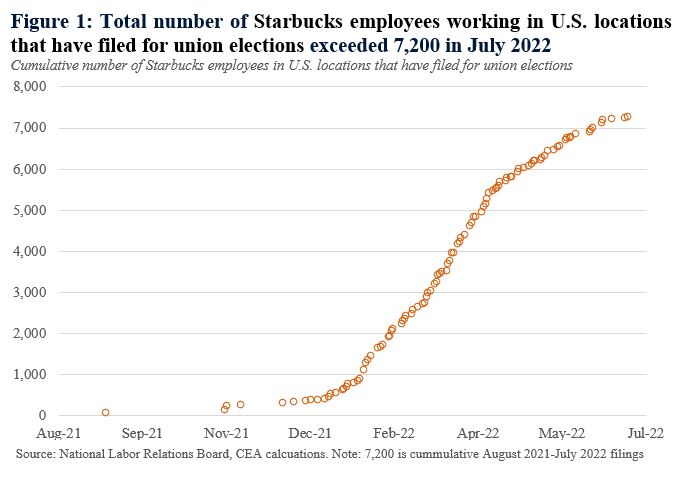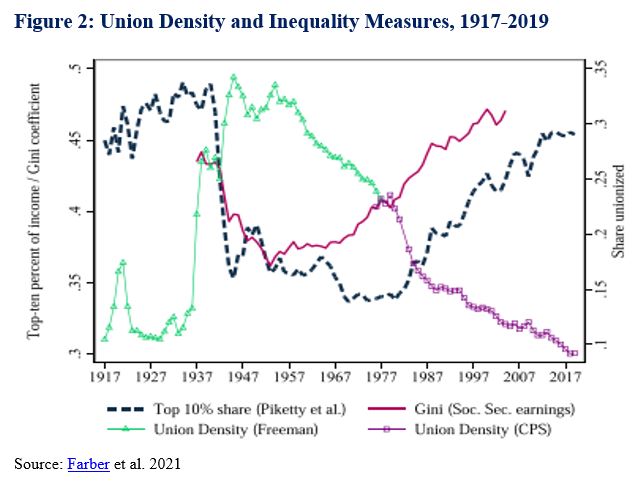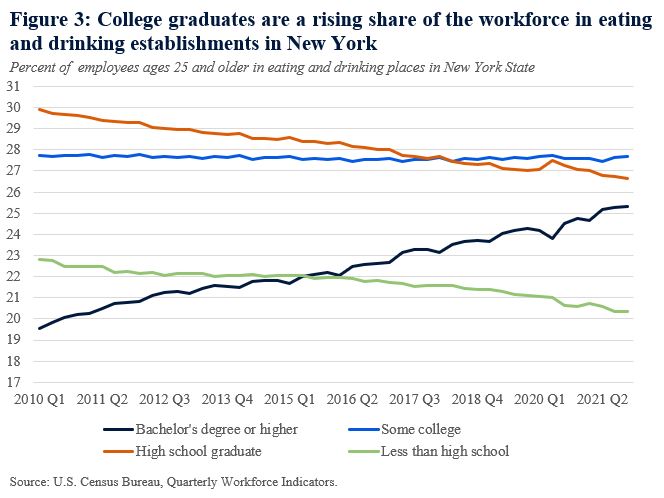The State of Our Unions
Organized labor appears to be having a moment. After decades of erosion in the private sector, U.S. workers are organizing at a pace not seen in many years. In December 2021, a Starbucks in western New York became the first to unionize, sparking a wave of union elections in stores across the country (see Figure 1). First-ever unions have also formed at an Amazon warehouse in Staten Island, an Apple store in Maryland, and an REI store in New York City. This recent wave of worker organizing is partially concentrated among younger and more educated workers and in industries–including the service sector, but also media, tech, and think tanks–that have resisted organizing activities in the past.

Causes and consequences of decline in unionization
The current level of energy and momentum is a shift after a long period of decline in unionization in the United States. Union membership peaked in the 1950s at about one-third of the private sector workforce, but is just over 6 percent today. Globalization, technological change, and employer concentration are commonly cited as key factors, eroding union power and increasing employers’ bargaining position relative to workers. However, many economists have pointed out that these factors do not fully explain why unionization in non-tradable sectors has fallen at a similar rate, or why unionization is lower in the United States than other Western countries. Other potential causes for declining worker power include institutional changes within the United States–particularly the breakdown of pattern bargaining in the 1980s, the expansion of right-to-work states, outsourcing and industry concentration of low-wage workers, greater employer opposition to organizing efforts, and decreased enforcement of labor laws.
The consequences of union decline for workers include lower wages, and a declining labor share of income. The wage premium for unionized workers is well-documented, and union density may also improve wages for nonunionized workers in the same sector. Union density has also been shown to reduce income inequality, with Figure 2 showing how U.S. inequality rose as union density fell. In short, as unionization has fallen, middle-class worker incomes have stagnated relative to output growth.

The recent surge in worker organizing
Given this context, what explains the current uptick in organizing efforts? A historically-tight labor market, especially in the service sector, has increased workers’ leverage coming out of the pandemic. The pandemic may also have negatively impacted workers’ willingness to continue in public-facing jobs, perhaps in part prompted by many reports of abuse of servers and flight attendants during the pandemic. These negative shocks to work environments could increase demand for better pay and improved working conditions. Momentum has also likely played a role, especially in the case of Starbucks, where early successes have inspired similar efforts across the country.
The growing share of college-educated workers in the service sector may also be a factor in rising unionization efforts. Economists have argued that rising college-wage premiums in previous decades weakened unions by undermining the coalition between skilled and unskilled workers. However, since the Great Recession, young college-educated workers have been faring worse in the labor market relative to previous cohorts and are increasingly employed in low-wage sectors. For example, the number of college-educated workers in eating and drinking establishments in New York (including Starbucks) almost doubled between 2010 and 2020, becoming one-quarter of the total workforce (see Figure 3). Some of these young workers are driving recent unionization efforts, and more broadly, support for labor unions among college graduates has risen since the 1990s.

Rebalancing the scales between workers and employers
Support for unions is currently at a 57-year high, indicating strong public support for rebalancing the scales between workers and employers. However, this new generation of organizers face significant headwinds after decades of erosion in worker protections. The Biden Administration supports the Protecting the Right to Organize Act, or PRO Act, which would make it easier to unionize by preventing companies from holding mandatory anti-union meetings and imposing penalties on employers who retaliate against organizers. The Administration has also taken significant steps toward improving worker leverage, from appointing former union officials to the National Labor Relations Board, to establishing a task force to promote labor organizing, and adding prevailing wage and apprenticeship requirements to the recently passed CHIPS Act and Inflation Reduction Act. These are initial steps to improve worker bargaining power, which has significantly weakened since the 1970s.

